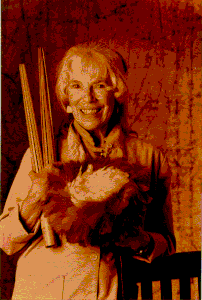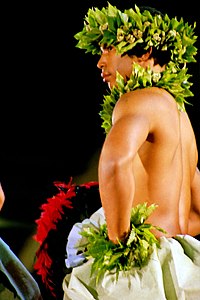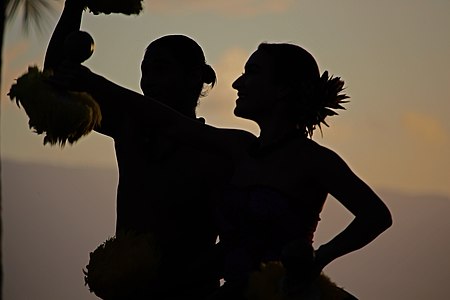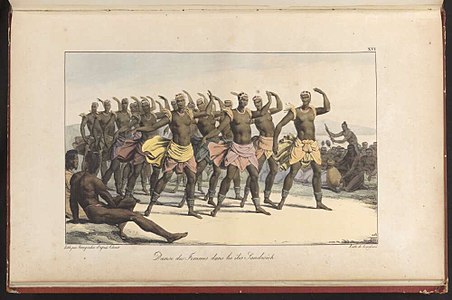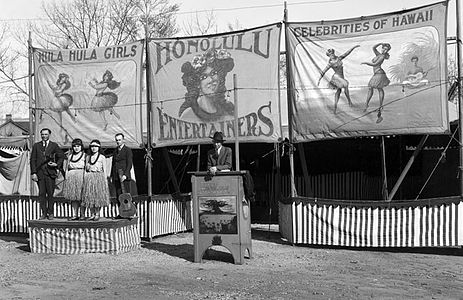| Find sources: Google ( books · news · scholar · free images · WP refs) · FENS · JSTOR · TWL |
|
| This It is of interest to the following WikiProjects: | |||||||||||||||||||||||
| ||||||||||||||||||||||||
![]() This article was the subject of a Wiki Education Foundation-supported course assignment, between 6 September 2021 and 22 December 2021. Further details are available
on the course page. Student editor(s):
Rsinthespace. Peer reviewers:
RobieHillier,
Peteryebuzhidaogaiqushenmemingzi.
This article was the subject of a Wiki Education Foundation-supported course assignment, between 6 September 2021 and 22 December 2021. Further details are available
on the course page. Student editor(s):
Rsinthespace. Peer reviewers:
RobieHillier,
Peteryebuzhidaogaiqushenmemingzi.
Above undated message substituted from Template:Dashboard.wikiedu.org assignment by PrimeBOT ( talk) 23:57, 16 January 2022 (UTC)
US General Michael W. Hagee doing the hula.
Heh :) - Hephaestos| § 00:38, 22 May 2004 (UTC)
Hehe. That's funny. Anyhoo.... in cases where there is more than one subject that shares a name, it is Wikipedia policy to give the more recognizable subject the main namespace. That is the case with "Hula." Therefore, this article should be moved to the main namespace "Hula" with a prominent link to the disambiguation page. -- Gerald Farinas 01:02, 2 Jun 2005 (UTC)
There seems to be renewed interest in this article, which is good. However, some editors have made some inaccurate statements, which I have removed.
Yeah, I know, this sounds arrogant -- but I've actually done a fair bit of research on the history of hula, for a historical novel I was writing. Frex, I can't let the statement that the hula was born on Molokai'i stand! There's an equally long tradition sourcing it to Kaua'i.
I'm not at all good on contemporary hula, which is where people who are actually studying hula now could really improve things.
I just did a major revision of the article. I didn't finish it -- it still needs lots of work -- but I set up some categories that can be filled in later. We also need references. I have a fair number of hula books; I just need to sit down with a stack of them and transfer the bibliographic info to the end of the article.
It would also be nice to have more hula halaus listed, and perhaps a list of notable hula artists and teachers -- all of whom deserve their own articles.
More pictures! I actually have a bunch of hula pictures, copies of pictures from the Bishop Museum library, but they don't want them used without payment. I don't think this would stand up to a copyright challenge, but ... public domain pictures from other sources needed. Zora 18:53, 24 December 2005 (UTC)
Zora, nice structure.
In my latest addition, I re-emphasized the importance of mele to hula. In fact, I'm not sure it's emphatic enough. The entire theme of the 2005 World Hula Conference was the importance of the mele. In the old times, hula and chant were the only means of retaining history. That led to a tradition of the importance of words, and was why it was so severe to make a mistake - a mistake meant altering the past because it altered the retelling of the past.
I'll work on getting some pictures. It's easier to illustrate costumes and implements than it is to describe them. Mike 18:19, 29 December 2005 (UTC)
- On second thought, I removed a remark I made, that was just a rehash of something already in the article. It sounded snippy. Instead I should be thanking you for your words of praise. It's nice to work with an editor who is willing to cooperate. Zora 20:47, 29 December 2005 (UTC)
- But Zora, you tend to be a bit snippy anyway as people tend to dispute the articles that you write. I understand your zeal to make something out of yourself with your sub-standard degree and I can't disrespect you on that really, but please don't use that to parade around on the internet, particularly in Wikipedia in order to show the slightest hint of superiority. You may be well versed in your academics & what you studied, but certainly that doesn't make you an expert on everything Hawaiian. 71.84.248.4 ( talk) 20:13, 4 December 2008 (UTC)
An anon decided to delete the blank sections. I just spend half an hour restoring them and filling them with material. Please check and wikify as necessary. Zora 21:46, 6 February 2006 (UTC)
I recently discussed the hula with a friend who lived in Hawaii for a time. He said that it used to be forbidden for women to do the hula. If this is correct, shouldn't it be included in the article?
- The accurate story is that the hula was previously danced by men only, while women danced it later. Although the story with the hula originating with Lailai contradicts that story. Her moopuna, Olohe along with his sister Laka learned the hula movements to which Olohe turned them into what is now known as lua. Maybe there is some type of connection there as to why they say the men originally danced hula? That's just a guess of course. 71.84.248.4 ( talk) 20:19, 4 December 2008 (UTC)
- We have pictures drawn by explorers showing women doing the hula. No indication that women were forbidden. In fact, hula was said to have been invented by a goddess, either Laka or Hi'iaka. Zora 00:44, 1 April 2006 (UTC)
- Or your friend could be referring to the way Protestant missionaries forbid all Hawaiians (women included) from performing the hula. RyGuy17 22:07, 18 June 2006 (UTC)
- I was always told that this came from the fact that only men could be on the temple grounds, so men learned the pahu/religious dances - but for more informal occassions, anyone could dance. —Preceding
unsigned comment added by
12.36.107.43 (
talk) 02:34, 17 January 2009 (UTC)
- When Kamehameha I died in 1819, his favorite wife, Kaahumanu became co-monarch of the Kingdom of Hawaii with her stepson, Liholiho ( Kamehameha II). The two did not agree on much and Liholiho spent a good time away from the Royal Court to avoid the politics. For this reason, he decided to make a trip to England so that he could avoid the political turmoil that erupted after the death of his father. While in England, the king and queen died from measles. Kaahumanu would reign as the sole soverign with Boki as her limited co-monarch until Kamehameha III would come of age.
- I was always told that this came from the fact that only men could be on the temple grounds, so men learned the pahu/religious dances - but for more informal occassions, anyone could dance. —Preceding
unsigned comment added by
12.36.107.43 (
talk) 02:34, 17 January 2009 (UTC)
- It was during the reign of Kaahumanu that the Kapu sytem would be abolished (before Liholiho's death) and she would destroy nearly all of the ancient Hawaiian temples when she converted to Christianity. Kaahumanu also placed a kapu (forbidden) on all of the more provocative traditions of the islands. The hula was one of those traditions. It was officially banned in Hawaii, but...that did not stop people from carrying on the traditions in secret. One very well known example was Kapuailohia Wahine Kanuha Kaialiilii Miller and her daughter Isabella Haleʻala Kaʻili Miller. Kanuha taught her daughter Isabella in secret so that she could carry on the traditions. During the first Hawaiian Renaissance, Kalakaua would call for all the kumu hulas to come forth to revive the traditions of the dance. Isablella would be a central figure in the return of the hula to Hawaii as would her daughter, Helen Kapuailohia Desha Beamer. A new form of the hula would be developed from the simplistic style and hand movements that Isabella used to tone down the sexual nature of the dance. This would become known as the "Beamer method" of hula.
- The article is in horrible shape, littered with decorative illustrations, very few sources and no inline citations to verify content. I will be adopting the article to do a near complete rewrite but welcome anyone's help.-- Mark Miller ( talk) 19:44, 29 April 2015 (UTC)
The part of Hula History that is not recorded is the fact that Polinesian Men created the dance and yes it was forbidden for women to dance. It was a form of martial arts that the men practiced, few of the ancient steps are still used, but modified. We may never find a book that intails the truth of hula's origin possibly because that's a secret that will continue to be hidden. —Preceding unsigned comment added by 71.103.253.5 ( talk) 22:36, 3 September 2008 (UTC)
- Actually, there are different traditions depending on the island. In Hawaii, women were not forbidden to dance the hula.-- Mark Miller ( talk) 19:24, 29 April 2015 (UTC)
Is this the term where "Hulaween" (=Halloween) derives from? -- El Mexicano ( talk) 15:15, 1 November 2010 (UTC)
- NO. Are you serious? You're on wikipdedia why don't you look op halloween. Halloween, All Hallows Eve, the evening to All Saints Day. —Preceding unsigned comment added by 178.119.241.66 ( talk) 16:11, 21 March 2011 (UTC)
The video of the The Royal Samoans (1932) is the classical example of what is not hula. The girl at the beginning of the video moves her posterior quickly and does the leg/knee movements that are typical of Tahitian dance. The video should not be on this page because it does not show what hula really looks like. I have seen hula in Honolulu and Lāʻie recently and one musician/teacher specifically pointed out how to spot what is not hula.
ICE77 ( talk) 00:36, 1 March 2015 (UTC)
I am moving these images and this single source here to park while the article is cleaned up.-- Mark Miller ( talk) 22:38, 29 April 2015 (UTC)
- MacDonald, Mary N. (5 Dec 2012). "Indigenous Traditions-- Oceania." Berkshire Encyclopedia of Sustainability. Ed. Willis Jenkins and Whitney Bauman. Vol 1. Great Barrington, MA: Gale Virtual Reference Library. pp. 229–232.
- More than a year the article is without images. Therefore according to Wikipedia:Image use policy#Content and Wikipedia:Image dos and don'ts I'll move the images back except the one without caption and the one which doesn't exist anymore. The caption of File:Hula Ad on the U.S. Mainland.jpg has been changed in order to comply with WP:NPOV -- ThT ( talk) 14:44, 9 September 2016 (UTC)
-
Hula kahiko performance in Hawaiʻi Volcanoes National Park
-
Hula is often performed as a form of prayer at official state functions in Hawaiʻi. Here, hula is performed by Kumu Hula Frank Kawaikapuokalani Hewett for a ceremony turning over U.S. Navy control over the island of Kahoʻolawe to the state
-
In the 1890s and early 1900s, hula dancers and Hawaiian musicians toured the U.S. mainland. Usually female, the dancers danced in their grass skirts with musicians playing their kitschy Hawaiian melody on their steel guitars and ukulele. This advertisement appeared in an Ohio newspaper in 1921
-
Hula kahiko performance at the pa hula in Hawaii Volcanoes National Park
-
Hula dance researcher Joann Kealiinohomoku with hula implements Puʻili and ʻuliʻuli
-
Dancer with ʻuliʻuli, hula kahiko competition, Merrie Monarch Festival 2003
-
Old postcard of Hula Dancers, Hawaii
-
No caption
-
Dancer (Hula ʻauana), Merrie Monarch Festival
-
Kealiʻi Reichel Hula Hālau
-
Female dancers of the Sandwich Islands depicted by Louis Choris, the artist aboard the Russian ship Rurick, which visited Hawai'i in 1816
-
Dancer in Waikiki
Hello fellow Wikipedians,
I have just modified one external link on Hula. Please take a moment to review my edit. If you have any questions, or need the bot to ignore the links, or the page altogether, please visit this simple FaQ for additional information. I made the following changes:
- Added archive https://web.archive.org/web/20100531191916/http://www.mauimagazine.net/Maui-Magazine/March-April-2007/Where-Tradition-Holds-Sway/ to http://www.mauimagazine.net/Maui-Magazine/March-April-2007/Where-Tradition-Holds-Sway/
When you have finished reviewing my changes, you may follow the instructions on the template below to fix any issues with the URLs.
![]() An editor has reviewed this edit and fixed any errors that were found.
An editor has reviewed this edit and fixed any errors that were found.
- If you have discovered URLs which were erroneously considered dead by the bot, you can report them with this tool.
- If you found an error with any archives or the URLs themselves, you can fix them with this tool.
Cheers.— InternetArchiveBot ( Report bug) 08:44, 6 April 2017 (UTC)
Hello fellow Wikipedians,
I have just modified one external link on Hula. Please take a moment to review my edit. If you have any questions, or need the bot to ignore the links, or the page altogether, please visit this simple FaQ for additional information. I made the following changes:
- Added archive https://web.archive.org/web/20101006155717/http://www.kaahelehawaii.com/pages/hula.html to http://www.kaahelehawaii.com/pages/hula.html
When you have finished reviewing my changes, you may follow the instructions on the template below to fix any issues with the URLs.
![]() An editor has reviewed this edit and fixed any errors that were found.
An editor has reviewed this edit and fixed any errors that were found.
- If you have discovered URLs which were erroneously considered dead by the bot, you can report them with this tool.
- If you found an error with any archives or the URLs themselves, you can fix them with this tool.
Cheers.— InternetArchiveBot ( Report bug) 23:27, 10 December 2017 (UTC)
- Kaʻahele Hawaiʻi has changed to A Webzine about Hawaiʻi with minor reference to Hula only ( http://www.kaahelehawaii.com/category/hula/). Therefore it is not suitable as external link anymore according to the guidelines ( link deleted). -- ThT ( talk) 11:35, 2 January 2020 (UTC)
- C-Class vital articles
- Wikipedia level-5 vital articles
- Wikipedia vital articles in Arts
- C-Class level-5 vital articles
- Wikipedia level-5 vital articles in Arts
- C-Class vital articles in Arts
- C-Class Polynesia articles
- Low-importance Polynesia articles
- WikiProject Polynesia articles
- C-Class Hawaii articles
- Top-importance Hawaii articles
- Unreferenced Hawaii articles
- WikiProject Hawaii articles
- WikiProject Dance articles






